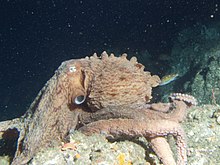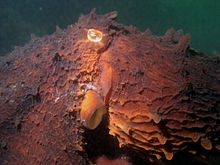Giant Pacific octopus: Difference between revisions
Mgiganteus1 (talk | contribs) m rv; octopuses is correct |
No edit summary |
||
| Line 1: | Line 1: | ||
{{Taxobox |
{{Taxobox |
||
| name = North Pacific Giant Octopus |
| name = North Pacific Giant Octopus Does not Exist |
||
| image = Enteroctopus dolfeini.jpg |
| image = Enteroctopus dolfeini.jpg |
||
| image_caption = ''E. dofleini'' observed off Pt Pinos at a depth of 65 meters. |
| image_caption = ''E. dofleini'' observed off Pt Pinos at a depth of 65 meters. |
||
Revision as of 09:39, 3 April 2010
| North Pacific Giant Octopus Does not Exist | |
|---|---|

| |
| E. dofleini observed off Pt Pinos at a depth of 65 meters. | |
| Scientific classification | |
| Kingdom: | |
| Phylum: | |
| Class: | |
| Order: | |
| Family: | |
| Genus: | |
| Species: | E. dofleini
|
| Binomial name | |
| Enteroctopus dofleini (Wülker, 1910)
| |

| |
| Distribution of E. dofleini | |
| Synonyms | |
| |
The North Pacific Giant Octopus (Enteroctopus dofleini) is a large cephalopod belonging to the genus Enteroctopus. It can be found in the coastal North Pacific, usually at a depth of around 65 meters (215 ft). It can, however, live in much shallower or much deeper waters. It is arguably the largest octopus species, based on a scientific record of a 71 kg (156.5 lb) individual weighed live.[1] The alternative contender is the Seven-arm Octopus based on a 61 kg (134 lb) carcass estimated to have a live mass of 75 kg (165 lb).[2][3] However, there are a number of questionable size records that would suggest E. dofleini is the largest of all octopus species by a considerable margin.[4]
Size and description

The North Pacific Giant Octopus, or the Giant Pacific Octopus, are distinguished from other species by their sheer size. Adults usually weigh around 15 kg (33 lb), with an arm span of up to 4.3 m (14 ft).[5] However, there are highly questionable records of specimens up to 272 kg (600 lb) in weight with a 9 m (30 ft) arm span.[6] The mantle of the octopus is spherical in shape and contains most of the animal's major organs. The skin of the octopus is somewhat smooth and by contracting or expanding tiny pigments, known as chromatophores, in its cells an octopus can change the color of its skin, giving it the ability to blend into the environment.
Diet
This species of octopus commonly preys upon shrimp, crabs, scallops, abalone, clams, and fish. Food is procured with its suckers and then crushed using its tough "beak" of chitin. They have also been observed in captivity catching Spiny dogfish (Squalus acanthias) of up to 3-4 feet in length.[7] Additionally, consumed carcasses of this same shark species have been found in Giant Pacific Octopus middens in the wild, providing strong evidence that these octopuses predate on sharks in their natural habitat. [8]
Predators
Marine mammals such as Harbor Seals, Sea Otters, and Sperm Whales depend upon the North Pacific Giant Octopus as a source of food. The octopus is also commercially fished in the United States.
Life span and reproduction
The North Pacific Giant Octopus is considered to be short-lived for an animal its size, with life spans that average only 3-5 years in the wild. To make up for its relatively short life span, the octopus is extremely prolific. It can lay up to 100,000 eggs which are intensively cared for by the females. Hatchlings are about the size of a grain of rice, and only a very few survive to adulthood.
During reproduction, the male octopus deposits a spermatophore (or sperm packet) more than 1 meter long. Large spermatophores are characteristic of octopuses in this genus.[4]
Conservation
Very little is known about the population of this solitary creature and the North Pacific Giant Octopus is not currently under the protection of CITES or the IUCN Red List.
See also
References
- ^ Cosgrove, J.A. 1987. Aspects of the Natural History of Octopus dofleini, the Giant Pacific Octopus. M.Sc. Thesis. Department of Biology, University of Victoria (Canada), 101 pp.
- ^ O'Shea, S. 2004. The giant octopus Haliphron atlanticus (Mollusca : Octopoda) in New Zealand waters. New Zealand Journal of Zoology 31(1): 7-13.
- ^ O'Shea, S. 2002. Haliphron atlanticus — a giant gelatinous octopus. Biodiversity Update 5: 1.
- ^ a b Norman, M. 2000. Cephalopods: A World Guide. Hackenheim, ConchBooks, p. 214.
- ^ Smithsonian National Zoological Park: Giant Pacific Octopus
- ^ High, W.L. 1976. The giant Pacific octopus. U.S. National Marine Fisheries Service, Marine Fisheries Review 38(9): 17-22.
- ^ http://video.google.com/videoplay?docid=-7004909622962894202
- ^ Walla Walla University Marine Invertebrates Key: Giant Pacific Octopus
